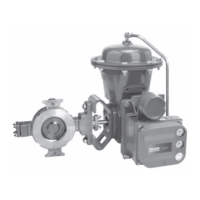8580 Valve
Instruction Manual
March 2010
4
same valve body to accept both soft and metal
seals.
Installation
Key numbers in this procedure are shown in figure
10 unless otherwise indicated.
WARNING
Always wear protective gloves,
clothing and eyewear when performing
any installation operations to avoid
personal injury.
To avoid personal injury or property
damage resulting from the bursting of
pressure retaining parts, be certain the
service conditions do not exceed either
the valve body rating or the flange joint
rating, or other limits given in table 1 or
on the nameplate. Use pressure-relieving
or pressure-limiting devices to prevent
the service conditions from exceeding
these limits.
If installing into an existing
application, also refer to the WARNING
at the beginning of the Maintenance
section on page 6 in this manual.
CAUTION
The valve configuration and
construction materials were selected
to meet particular pressure,
temperature, pressure drop, and
controlled fluid conditions specified in
the customer’s order. Because some
valve body/trim material combinations
are limited in their pressure drop and
temperature range capabilities, do not
apply any other conditions to the valve
without first contacting your Emerson
Process Management sales office.
The maximum allowable inlet pressures for steel and
stainless steel valve bodies are consistent with the
pressure-temperature ratings shown in table 1,
except where further limited by the trim and packing
material temperature capabilities given in table 3.
Valves are also available in CW2M and M35-2 valve
body materials that are not listed in
EN 12516-1 or ASME B16.34. Valve bodies
constructed of these materials mate with EN and
ASME flanges but are not included in EN or ASME
pressure-temperature ratings and must not be
installed in systems requiring conformance to EN or
ASME standards. Maximum allowable inlet
pressures for 8580 valve bodies made of CW2M or
M35-2 construction materials are shown in table 4.
1. Install a three-valve bypass around the control
valve assembly if continuous operation is necessary
during inspection and maintenance of the valve
body.
2. Inspect the valve body to be certain it is free of
foreign material.
3. The valve is normally shipped as part of a control
valve assembly, with an actuator mounted on the
valve body.
If the valve body and actuator have been purchased
separately or if the actuator has been removed for
maintenance, mount the actuator, and adjust
actuator travel before inserting the valve body into
the line. This is necessary due to the measurements
that must be made during the actuator adjustment
process. Refer to the Actuator Mounting section on
page 15 of this manual and to the separate actuator
instruction manual for mounting and adjusting
instructions before proceeding.
4. Inspect adjacent pipelines to be certain they are
free of any foreign material, such as pipe scale or
welding slag, that could damage the valve body
seating surfaces.
CAUTION
Damage to the disk (key 3) will occur if
any pipe flanges or piping connected
to the valve body interfere with the
disk rotation path. However, the disk
can be rotated without interference
when the valve body is installed
between adjacent pipe flanges or
piping that has an inside diameter
equal to or greater than either
schedule 80 pipe or compatible EN
pipe sizes. If piping with a smaller
inner diameter than specified above is
connected to the valve, measure
carefully to be certain the disk rotates
without interference before putting the
valve into operation.

